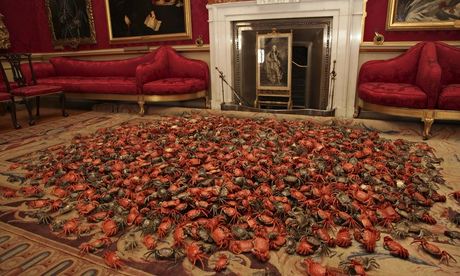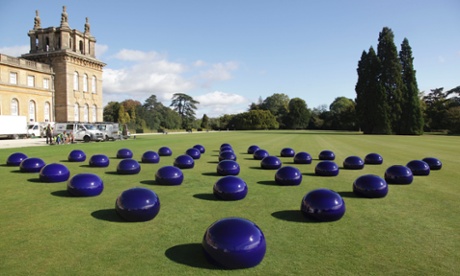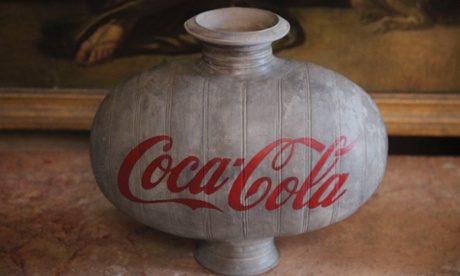From: maghiel van crevel <M.van.Crevel@hum.leidenuniv.nl>
Source: The Guardian (9/26/14): http://www.theguardian.com/artanddesign/2014/sep/26/ai-weiwei-among-greats-opulence-blenheim
Ai Weiwei takes his place among the greats amid the opulence of Blenheim
Modern chinoiserie and myths of east and west meet in a chaotic, hilarious, liberating vision of history gone mad

Everyone in the world knows by now that Ai Weiwei is a man of courage, a devastatingly effective political artist and campaigner. His new exhibition at Blenheim Palace, seat of the dukes of Marlborough and one of Europe’s great secular buildings, reveals that he also has a diabolical sense of humour.
Who but a born joker would put on the most comprehensive British survey of his art at a stupendous stately home where it will mostly be seen by visitors who come for the Capability Brown gardens and the tea shop – and perhaps not for the conceptual art.
The 88-year-old 11th Duke of Marlborough ambled into his front hall to open the exhibition, welcoming the press amid resounding pilastered grandeur to which Ai has added a colossal chandelier that looks from below like a time machine’s nuclear heart. It drips with magnificence, stealing the show even in these opulent surroundings.
After the elderly duke’s benign welcome, one of his sons, Lord Edward Spencer-Churchill, explained why he has created the Blenheim Art Foundation. Standing in the Long Library, where photographs of Ai giving the finger to various buildings all over the world, including the White House and Tate Modern, are hung sideways among the family heirlooms, he says contemporary art is more interesting in a setting like this than in some clean modern space. “I think the white box presentation of contemporary art is almost a kind of art apartheid.”

In truth, interventions by contemporary artists in stately homes, cathedrals and suchlike venerable venues are themselves not exactly new. What makes this so different and striking is that Ai – working from his studio in Beijing as he is unable to leave China due to the state’s attentions – has orchestrated a full-scale retrospective in these archaic surroundings. Why did he do it? Spencer-Churchill can only guess why he accepted the invitation.
“I think the Churchill connection was very important for him,” he suggests.
For this is the house where Winston Churchill was born. The part of the house where the great war leader came into the world is preserved as a shrine. Beside Churchill’s purple velvet “siren suit” and slippers, Ai shows a decadent-looking vegetative creation. Above the bed in the room officially called Churchill’s Birth Room, he has hung a profile of Marcel Duchamp made out of a wire coat hanger.
Duchamp unleashed complete freedom in art. Is he then the Churchill of art? But the mood is one of mad laughter. Ai seems to be having some immense joke by showing his art so copiously in such ripely historic surrounding. Is he metaphorically giving the finger to Blenheim itself or, more likely, to us, we British?
We may like to think we are best known globally for cool modern icons such as Tate Modern, where Ai’s Sunflower Seeds caused a sensation in 2010, but in reality it is Downton Abbey and the monarchy that define us to the world.
Meanwhile, Ai has become a symbol of “China” and his face now shares space with Ming porcelain as a stereotyped cultural image of his nation.

In this exhibition those and other myths of east and west meet in a chaotic, hilarious, liberating vision of history gone mad.
In the Red Drawing Room, a sea of porcelain crabs have crawled out of the fireplace. These immaculately made simulacra of nature – each a perfectly crafted and painted creature – swarm the room. You can taste crab, can imagine them thrown in the cooking pot. In the Green Drawing Room, ancient Han dynasty vases painted in metallic car-body colours sit on a table. Yet behind these installations arrays of older Chinese porcelain can be seen.
This place is full of China.
The taste for Chinoiserie is everywhere in Blenheim Palace, as you’d expect of an English stately home that has been accumulating luxuries since the 1700s. Part of the comedy of this exhibition is seeing Ai’s conceptual art next to all these fine crafts from China that have so long been just part of the decor.
Now it’s a Chinese artist who uses one of Britain’s noblest architectural masterpieces as a decorative backdrop. His wooden map of China is in the First State Room, his golden zodiac heads in a dining room, his marble surveillance camera in the library. Everywhere you look, the tapestries and paintings and furnishings are interrupted by his provocative Duchampian gestures.
Ai Weiwei truly is Duchamp’s heir. Like Duchamp, he sees art as a playing field with no rules. Duchamp stuck a bicycle wheel on a stool to make, or rather “choose”, the first readymade. Ai shows, in Blenheim’s Green Writing Room, a spiralling assemblage of antique wooden stools made in the Qing dynasty. His freedom ranges across time and space, with no respect for any authority (including that of connoisseurs who may shudder to see historical artefacts used as readymades).
Another freedom he takes is the freedom from preconceptions. You think he is a “Chinese” artist? Maybe he is a European Baroque one, for his art shares the spiky, bulbous, tumultuous energy of this Baroque building raised in the early 1700s by Sir John Vanbrugh. At times his art – Coca-Cola vases in the hall – seems to mock its surroundings but at other moments he and Blenheim Palace become one. Who would guess his carpet leading out of the great hall was a contemporary artwork if not told? When you do look down, you see a dreamlike landscape unfold. It is called Soft Ground.
The final freedom that Ai claims here is from his own global image. He is a man, not a brand. He may be best-known for defying power, but he’s not likely to change the world with an exhibition at Blenheim Palace. This magical feast of images and ideas reveals him purely as an artist. He is a great one.
• Ai Weiwei at Blenheim Palace, Oxfordshire, 1 October – 14 December 2014